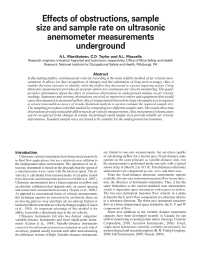Mining Publication: Effects of Obstructions, Sample Size and Sample Rate on Ultrasonic Anemometer Measurements Underground
Original creation date: January 2012
In fluctuating airflow, continuous air velocity recording is the most reliable method of air velocity measurement. It allows for fast recognition of changes and the calculation of long-term averages. Also, it enables the mine operator to identify when the airflow has decreased to a point requiring action. Using ultrasonic anemometers provides an accurate option for continuous air velocity monitoring. This paper provides information about the effect of common obstructions in underground mining on air velocity readings. Stationary and moving obstructions are used to represent workers and equipment that would cause discrepancies in measured airflow. Also, it is important to know how large of a sample size is required to ensure reasonable accuracy of results. Statistical analysis is used to evaluate the required sample size. The sampling procedure is further studied by comparing two different sample rates. The results show that obstructions provide noticeable differences in air velocity measurements. Also, movement of obstructions can be recognized from changes in results. Surprisingly small sample sizes provide reliable air velocity information. Standard sample rates are found to be suitable for the underground environment.
Authors: AL Martikainen, CD Taylor, AL Mazzella
Peer Reviewed Journal Article - January 2012
NIOSHTIC2 Number: 20040459
Trans Soc Min Metal Explor TP-11-025, 2012 Jan; 330:585-590
See Also
- Atmospheric Monitoring
- Evaluating Factors Affecting the Performance of Three-Axis Ultrasonic Anemometers
- Experimental and Modeling Investigation of the Effect of Ventilation on Smoke Rollback in a Mine Entry
- In-depth Survey Report: Control Technology for Environmental Enclosures - The Effect of Wind Speed Upon Aerosol Penetration Into an Enclosure at Clean Air Filter, Defiance, IA
- Laboratory Testing To Quantify Dust Entrainment During Shield Advance
- Measurement of Airflow in a Simulated Underground Mine Environment Using an Ultrasonic Anemometer
- Sonic Anemometer Airflow Monitoring Technique for Use in Underground Mines
- Time-Lapse Tomography of a Longwall Panel: A Comparison of Location Schemes
- Using Ultrasonic Anemometers to Evaluate Face Ventilation Conditions
- Using Ultrasonic Anemometers to Evaluate Factors Affecting Face Ventilation Effectiveness
- Content source: National Institute for Occupational Safety and Health, Mining Program


 ShareCompartir
ShareCompartir
